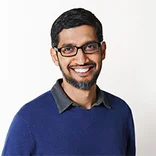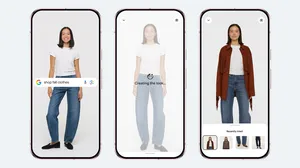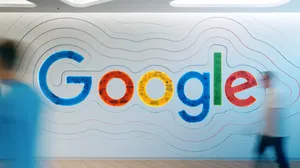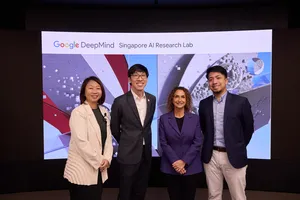A more inclusive global digital economy
Editor’s Note: The following is adapted from remarks delivered by Sundar Pichai, CEO of Google and Alphabet, at the Singapore FinTech Festival today on the need and opportunity to build a more inclusive global digital economy.
Thank you to the Monetary Authority of Singapore for the invitation to speak today—and for hosting this important event. While I hope we can have these big conversations in person again soon, I am grateful for all the ways that technology has kept us connected during the pandemic.
We’ve seen this year how online has been a lifeline. In Southeast Asia, 8 out of 10 people said that technology helped them navigate the pandemic, whether it was families searching for the latest COVID-19 information, small businesses using digital tools to reach new customers or students continuing to learn remotely.
Being helpful in these moments is at the core of Google’s mission to organize the world’s information and make it universally accessible and useful. We’re proud that users turned to products like Search, YouTube, and Maps to help people get through uncertainty, and that tools like Meet and Google Classroom helped keep people connected and businesses productive in these times.
Southeast Asia’s digital transformation
COVID-19 has accelerated the adoption of digital tools and trends by years. As a result, the Southeast Asian internet economy is on the verge of a massive transformation. A recent report we did with Temasek and Bain & Company shows that more than 40 million people in the region connected to the internet for the first time in 2020—that’s four times as many as the year before. In addition, one in three digital service consumers were new to a service, like virtual learning or buying groceries online. And 90 percent intend to continue using that service post-pandemic.
These digital trends aren’t just happening in cities. In places like Indonesia, Malaysia, and the Philippines, more than half of first-time users were from outside metropolitan areas, which shows huge promise for closing the urban-rural digital divide.
While COVID has accelerated the use of digital tools, it’s also exposed how many people are still left behind: from the 1.7 billion people around the world who are still unbanked, to the huge portion of African households without access to broadband, to millions of women entrepreneurs who lack the same access to opportunity as their male counterparts.
A more inclusive global digital economy
So the question is: how can we use this moment to reimagine a more inclusive digital economy? One that brings the benefits of the internet to everyone?
The answer is two-fold: First, by accelerating progress in closing the digital divide, which means expanding connectivity, financial inclusion, and digital skills. Second, by deepening partnerships between governments and business, which means building on the new collaborations we’ve seen during COVID.
Connectivity as the foundation
The question of inclusion and opportunity is deeply personal to me. Growing up in India, I didn’t have much access to a computer, or a phone. To make a call, I had to wait in long lines to use a shared phone with everyone else. So when our family finally got our first rotary phone, it changed our lives for the better, and it set me on a course to help bring technology to more people around the world.
Today, an internet connection is the single best way to make technology available to more people. At Google, we are focused on the infrastructure—like the subsea cables we’re building between Western Europe and the West Coast of Africa, as well as the affordable, low-cost devices that can transform digital access—something our Android teams are working on with Jio Platforms in India.
Increasing financial inclusion with Google Pay
Of course, it’s not just about connecting to the internet that’s important, it’s about what people can do with that connectivity. One of the most exciting advancements is financial connectivity, which ensures that everyone can participate in the economic system.
That idea is what inspired us to launch Google Tez, now Google Pay, our first digital payment platform, in India in 2017. At the time, my home country was still largely a cash-based society. Since then, digital payments services have helped reshape how transactions are made. They’ve increased financial inclusion by making payments simple and seamless for over a hundred million Indians.
This historic shift has changed what’s possible for business owners like Vijay Babu, who runs a laundry shop in Bangalore. Two years ago, Vijay would have had to pay $100 for a credit card terminal, worry about printed receipts, and wait days to get paid.
Today, with Google Pay, and a little help from his daughter, Vijay is able to keep better track of his transactions, accept payments remotely, and build relationships with his customers.
There are many others like Vijay. People are using Google Pay to do everything from send money home to their families and split the check for dinner. Kirana store owners are using it to pay their business expenses, as well as receive payments from their loyal customers.
All told, people in India complete more than three billion digital transactions a month, two thirds of which are taking place outside India’s biggest cities. Digital payment transactions across Southeast Asia are set to almost double to $1.2 trillion by 2025.
Now, we’re using the same technology to improve Google Pay globally, starting in Singapore and the U.S., with more to come. And we’re partnering with organizations like the Gates Foundation, Omidyar Network, the Rockefeller Foundation and others to drive Mojaloop, a nonprofit creating open-source tools any country and organization can use to develop its own digital payments system.
Bringing digital skills and tools to more people
Connectivity is the foundation of a more inclusive digital economy. The next layer is ensuring that everyone, including small businesses, have access to digital skills and tools. One example is the work that the Asia Foundation is doing, with support from our philanthropic arm Google.org, to train 200,000 small business owners and workers across Southeast Asia.
This program means local nonprofits can help people like Lakela, an avocado farmer from Thailand who used YouTube to learn how to grow other types of fruit, and create new revenue streams for her business.
We’re also investing in the innovation ecosystem, including entrepreneurs and start-ups, to ensure digital economies are sustainable.
Power of partnerships
We can’t do any of this alone. That’s why partnerships are the second part of our agenda.
We have good models to build from. One of the bright spots in this year has been the strong partnerships forged between companies, governments, and NGOs, working together toward shared goals. Building a more inclusive digital economy will require this same spirit of collaboration.
A place to start is digital trade. In Southeast Asia alone, it’s estimated that expanding business and trade through technology could add $1 trillion to overall regional GDP by 2025. And it will help entrepreneurs grow across borders, leading to more jobs, better services and new opportunities.
Unlocking those benefits requires the right frameworks. Singapore and the Asia Pacific region are pioneering new approaches. New digital economy agreements could provide a template for other parts of the world, alongside broader trade deals like the new Regional Comprehensive Economic Partnership. By maximizing these digital agreements—and creating new ones—we can pave the way for a stronger, more inclusive digital economy.
From closing digital divides to forging new partnerships, our goal for the post-COVID world is to ensure the benefits of technology can be shared as widely and equitably as possible.
If we can do that, 2020 will be remembered not as the end of the world we knew, but the beginning of a world that works better, for everyone. We look forward to building that world alongside all of you.







